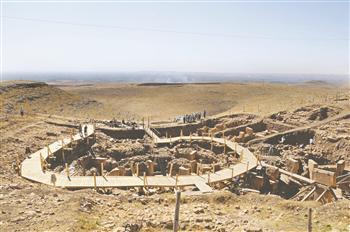Şanlıurfa’s Göbkelitepe, which is known as the oldest human-made religious structure and called the ‘zero point of civilizations,’ is preparing for a new excavation season to begin soon. The team will work on two campaigns

Göbeklitepe was declared a first-degree protected site by the Culture and Tourism Ministry in 2005. The people who inhabited the area 12,000 years ago were among the first humans to engage in agriculture along with hunting and gathering. It was first noted by a study conducted by Istanbul University and the University of Chicago in 1964.
This year’s excavations will begin soon in Göbeklitepe, which is regarded as the world’s oldest temple and commonly named the “zero point of civilization.” This ancient temple is located in the eastern province of Şanlıurfa.
The head of the Göbeklitepe excavations, Professor Klaus Schmidt has said that like in the past years, their team was planning to carry out two excavation campaigns this year. The spring works are set to begin in the coming days, and they will remove the preservation measures taken for winter conditions and clean the excavation area. “In this way, we will provide a visual environment for visitors,” he said.
Schmidt said that during the first excavation period they would focus on a “protective roof” in the place of historic artworks that they had brought to light during the previous excavations: “We will make excavations for the establishment of a protective roof, as the place where the roof will be established should be archaeologically examined. Scientific works will also continue in the new excavation area, but we will particularly focus on the establishment of this roof in the old excavation areas. As in previous years, this year a scientific team of 25 people will come for the excavations. Nearly 50 workers from Örencik village will support our works, too.”
Schmidt said there was a complicated motif of some 50 animal figures on the T-shaped pillar that was discovered in the previous season’s excavations. He said this was first of its kind, adding, “We see an eagle motif catching a snake on the same pillar, and it shows us that these figures tell us very developed stories. We will work with a team of foreign scientists and archaeologists in order to examine and solve the symbols on the artworks in Göbeklitepe. We are currently in the process of forming some international working groups to solve and understand this symbolic world. A working group will come to Şanlıurfa in October and a small symposium will be held on this issue.”
Ancient Neolithic site
Göbeklitepe was declared a first-degree protected site by the Culture and Tourism Ministry in 2005. The people who inhabited the area 12,000 years ago were among the first humans to engage in agriculture along with hunting and gathering.
It was first noted by a study conducted by Istanbul University and the University of Chicago in 1964, which recognized that Göbeklitepe could not only be a natural phenomenon. However, the study assumed that a Byzantine cemetery lay beneath, despite the fact that it also noted a large number of flints and the presence of limestone slabs, which were thought to be Byzantine grave markers.
In 1994, Schmidt visited the site and recognized that it was in fact a much more ancient Neolithic site. Since 1995, excavations have been conducted by the German Archaeological Institute’s Istanbul branch and the Şanlıurfa Museum, under Schmidt’s direction.
Prior to the excavation, the hill had been under agricultural cultivation. Generations of local inhabitants had frequently moved rocks and placed them in clearance piles which likely destroyed archaeological evidence. Scholars from the Hochschule Karlsruhe began documenting the architectural remains, and they soon discovered T-shaped pillars, some of which had apparently been smashed by vandals.